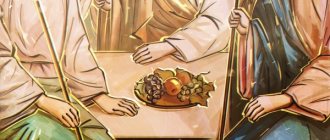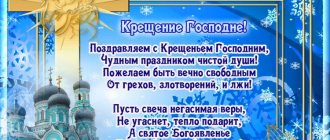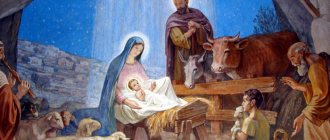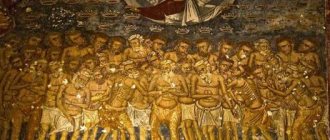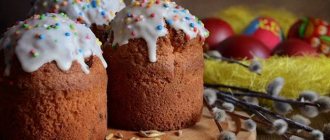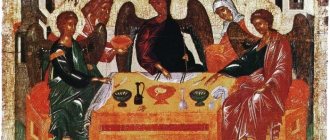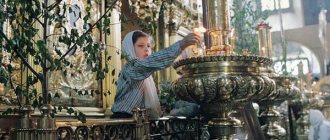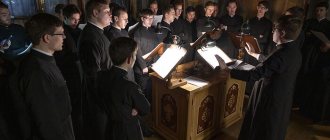For Orthodox Christians living in Russia, the second most important church holiday is coming - Nativity. The Russian Orthodox Church and other denominations living according to the Julian calendar celebrate Christmas from 6 to 7 January. In Russia, January 7 is a day off. Western Christians and Orthodox churches living according to the Gregorian calendar and the New Julian calendar coinciding with it celebrated Christmas from 24 to 25 December.
For more information about why Catholics and Orthodox Christians celebrate Christmas on different days, read the material from the Federal News Agency .
What is Christmas Eve
The name Christmas Eve comes from the word “sochivo” - cereal grains boiled in honey. This dish was used to break the fast after a very strict and long Nativity Fast , on the last day of which it was customary to refuse food altogether until the first star appeared in the sky, for which believers mistook the planet Venus. After the first star appeared in the evening sky, it was possible to break the fast with a soch, and then after the Christmas service, the believers sat down to a festive meal, including meat dishes.
Christmas Eve in Rus' was also called Kolyady, since from that time on believers (mostly children) walked around the courtyards and sang carols - folk Christmas carols.
pxhere.com/
Weather signs
- Early spring was promised with a snowstorm and frost on Christmas night.
- Frost predicted rich wheat shoots, which must be sown before Peter's Day, that is, before June 12.
- If frost fell after Christmas, then you can sow wheat after Peter’s Day.
- The stars are apparently not visible - buckwheat and peas will fill the bins
- A warm day with a cheerful drop means spring will be cold, and vice versa, a frosty day means warm spring.
- If January 6 is a sunny day, the year will be green, without drought.
- A lot of snow on the ground means a rich harvest.
- We noted how many days before Christmas the frost will appear. This meant how many favorable days there would be for sowing before Midsummer, which is celebrated on May 21.
- Bright, large stars on Christmas night promised a rich forest harvest of mushrooms and berries. If there are few stars, then there will be nothing at all.
- The Milky Way is dim - for bad weather, bright - for sunny days.
- A large amount of snow means an excellent grain harvest.
- The paths have turned black - there will be a lot of buckwheat.
Christmas Eve and the night before Christmas: Christmas fortune-telling, traditions and prohibitions
Fortune telling in Rus' was customary for a limited number of days a year. In winter, they used to tell fortunes from the night before Christmas and throughout the Christmastide - right up to Epiphany evening on January 18 (Epiphany is celebrated on January 19).
It was believed that at this time evil spirits walk the earth, but treat people condescendingly and even allow them to look into the other world. The Church has never approved of fortune telling or the wild celebration of Christmastide, but the tradition of “misbehaving” at this time with evil spirits is still alive today.
In Rus', fortune telling was mainly done by unmarried girls, and the custom was widespread in all levels of society - from simple peasant women to wealthy and educated noblewomen.
wikipedia.org / Simon Kozhin / CC BY-SA 3.0
Epiphany - January 18
January 5th (18th century) is the only fast day preceding the feast of the Epiphany. This is a reminder that the Lord, plunging into the waters of the Jordan, took upon himself the sins of people in order to later accept death for them on the Cross.
How to Prepare for Epiphany
Many, immersed in the joy of the Holy Days after Christmas, lose sight of the meaning of the coming of the Lord, His Birth. A strictly fast day is a reason to stop, look around, and perhaps prepare yourself to receive the Holy Mysteries.
Features of worship
The service includes the Royal Hours with the recollection of Gospel events , liturgies and St. Basil the Great , Vespers. At its end, the Great Blessing of the water, the Great Agiasma, takes place. It is distributed to believers.
Interesting fact
This water is no different from that consecrated at Epiphany itself. Many, not knowing this, strive to come for it on January 19, creating queues. But “experienced” believers know that Agiasma is also consecrated on the eve of the holiday.
In the past, there were different points of view in the Church on holding Epiphany Eve, which depended on the day of the week on which it fell.
18
January
1455
Once, on the eve of Epiphany, Rostov Archbishop Theodosius, on the occasion of Sunday, “Little Easter,” allowed the city’s believers not to fast, the monks to eat fish and milk, and the laity to eat meat. For this, Metropolitan Jonah of Moscow ordered the arrest of Theodosius. He even wanted to deprive the Bishop of Rostov of his department. The archbishop's repentance saved him from such drastic measures. Subsequently, the bishops made peace.
Fortune telling on girlish objects
For this fortune telling you need company. On the pre-Christmas evening, village girls gathered together for fortune telling in the upper room, and young beauties from other classes - in the living room.
On a special fortune-telling table (a dining table would also do) each person put one item she brought with her. These were mostly jewelry - earrings, rings, as well as coins, handkerchiefs and other girlish little things. Each girl, closing her eyes, took one of the objects with her left hand and tried to guess by touch what the New Year promised her. A coin means money, a ring means wait for matchmakers, a scarf means you have to cry and wipe away your tears, a spoon means abundance, etc.
pixabay.com/
Money signs
The financial well-being of the family has always been of great importance. They strived for it, took care of it and increased it. Attentive people noticed moments and situations that preceded either the accumulation or loss of finances. This is how Christmas money signs for money appeared. If you treat them with due respect, you can protect your finances.
- Generous and rich treats on the festive table.
- You cannot refuse carolers - the money will leave the house. (Here you will find Christmas carols).
- Give yourself a gift.
- Stepping in feces means money.
- Feed your pets generously on Christmas Eve.
- The cat brought prey into the house - to wealth.
- Seeing a live mouse means losing money.
- You can’t borrow – it will lead to losses.
- You cannot refuse to lend money - this will lead to financial losses.
- Finding jewelry means prosperity.
- On Christmas Eve you need to wear new, elegant things, otherwise poverty will set in.
- A large amount of fire in the house will indicate the path to wealth.
- If it snows, there will be plenty.
Christmas is a bright, joyful holiday. Signs on Christmas Eve help you set your priorities correctly, finish what has been bothering you, put your life in order and protect your home from troubles. Not a single sign appears just like that. This is the result of centuries of observation of coincidences. Therefore, you should not treat them with ridicule. It’s better to take action and make your life a little better and happier.
Fortune telling on a saucer
This famous fortune telling is also usually carried out in a large group. You need to put a white sheet on the fortune telling table (or just on a small round table). A large circle is drawn on the sheet, which will be a fortune-telling circle. The circle is divided in half, “yes” is written on one half, “no” is written on the other. You need to write all the letters of the alphabet around the entire circle in a clockwise direction. It makes sense to prepare for fortune telling in advance.
On the pre-Christmas evening, fortune-telling participants gather at the fortune-telling circle and light three candles, which is preferable for various magical rituals. It is advisable to turn off the rest of the light. After this, take the saucer, turn it over and heat it on one of the candles.
Then the heated inverted saucer is placed on the fortune telling circle. All fortune telling participants place their fingers on the inverted saucer, lightly touching the hot porcelain. After this, you need to say three times: “The spirit of such and such is being called!”
pixabay.com/
As a rule, in order to look into the future, famous writers and poets or someone from recently deceased mutual acquaintances are invited to be “assistants”. The most popular of those invited are Pushkin and Mayakovsky .
When the invited spirit “appears,” the saucer should be knocked, preferably three times. After this, you can contact the spirit with various questions, and try to find out the answers by the movement of the saucer. You can ask questions that require a “yes” or “no” answer, or ask something more complicated and try to read the “message” from the other world by moving the saucer towards different letters that will form words.
Two things are important here - cheat less and not take everything you “hear” from the spirits too seriously.
Fortune telling on mirrors
Fortune telling on mirrors is one of the most popular and considered “scary” fortune telling for the night before Christmas. On the evening of January 6, you need to place two mirrors opposite each other in a dark room and light a candle between them. Then the fortuneteller sits in front of one of the mirrors and carefully peers at the image. When the candle flame “multiplied” in the mirror begins to blur, the image of the betrothed may appear in a foggy image. Or maybe you dream of something terrible, so experienced fortune tellers advise to be careful - suddenly someone unexpected will appear from the mirrors and drag the beauty into the other world...
pixabay.com/PD
The Eve of the Nativity of Christ, Christmas Eve. The Eve (Evening) of the Nativity of Christ is filled with special anxious anticipation of the coming of the Savior into the world. Everyone is waiting for this: heaven, earth, creation, our hearts. And then the star flares up, and the sages and wise men, led by it, rush after it. Angelic singing is heard, and the shepherds listen to it. And now on this day chants are heard during the hours, which are usually called the Royal Hours (the Tsar-Emperor was always present at them in Byzantium). Along with the Old Testament prophecies about the Nativity of Christ, for the first time the words of the Gospel narrative about this great event sound on them - the first ray of good news about the Nativity of Christ. On Christmas Eve, pious believers do not eat food at all, and by ten o’clock in the evening they go to the temple, where they celebrate the holiday of the Nativity . Only when the first star appears - the symbol of the Star of Bethlehem - can you taste sochivo (a Lenten dish, which is a wheat or rice broth with honey and fruit). Hence the name of this day - Christmas Eve. The holiday of Christmas itself, according to the teachings of the Church, symbolizes the triumph of man’s reconciliation with God, foreshadows the redemptive feat of Jesus Christ and the renewal of human nature, struck by the fall of our ancestors. The day of the strictest fast is the eve of the Nativity of Christ, called Christmas Eve or Christmas Eve.
Nowadays, for some reason, many people think that Vecherie (Christmas Eve) begins in the evening when they come to the Christmas service. In fact, the Vespers service begins on the morning of January 6 and ends sometime in the afternoon. Before the revolution, it was considered obligatory to attend this service, because without Christmas Eve, what would Christmas be? The service of the Eve of Christmas Eve is performed according to the same model as the Eve of Epiphany. This is due to the fact that in ancient times the Nativity of Christ was celebrated together with Epiphany (Epiphany). In general, the appearance of God in the flesh, the revelation in Christ and through Christ of Divine grace were remembered. Nowadays the two great holidays are separated by twelve days, but their eves remain the same. Since ancient times, the Royal Hours have been celebrated at the Eve of Christmas and Epiphany. They are called so because the Greek emperors, and subsequently the Russians, were always present at them and during these hours many years were proclaimed to the kings. But the main content of the Royal Hours is the singing of psalms, troparions, and kontakia, which tell or prophesy about gospel events. On the festive Vespers all hours (1,3,9) are served one after another. So, in the morning you enter the temple and see that the Royal Doors are open. This means that the Royal Hours begin. In the middle of the temple, on a lectern, lies an open Gospel to commemorate the fact that the Lord came to earth to save all nations. The priest begins burning incense for the temple and the parishioners, and this brings to mind the frankincense and myrrh brought by the eastern wise men to the newborn King of the Jews. This is followed by Vespers in conjunction with the Liturgy. During Vespers, many proverbs are read, selected in relation to the Great Feast. In the reading of the proverbs, the secret of the Eternal Council of God for the salvation of people is revealed, the solemn fulfillment of the troparions, proclaiming the truth of this Council. This solemn service fills the souls of those praying with a reverent premonition of the approaching great event. On the Eve of the Nativity of Christ, after the dismissal of Vespers and Liturgy, the rite of “glorification” is performed. A candle is placed in the middle of the temple, signifying the star that appeared in Bethlehem. In front of her, the clergy and singers sing the troparion and kontakion of the holiday for the first time “in great voice.” In the hymns of the holiday services, the Holy Church calls the Nativity of Christ a mystery, revealed by God to men in the incarnation of the Son of God, for today God has come to earth and man has ascended to Heaven.
Features of worship
The eve of the Feast of the Nativity of Christ - December 24 - is called the Eve of the Feast.
The custom of celebrating the Vespers before the Feast of the Nativity of Christ is undoubtedly ancient. This is evident from the fact that already in the 4th century it was determined how to celebrate the Evening Eve if it happened on Sunday (Theophilus of Alexandria, right. 1).
If the Vespers occurs on a weekday, except Saturday and Sunday, then on this day in the morning the Great (or Royal) Hours are celebrated and then Vespers with the Liturgy of St. Basil the Great.
Sequence of hours sung at the Eve of the Nativity of Christ.
The great clock represents the combination of all four clocks into one service with the addition of a fine clock to them.
Each of the four Great Hours has special two psalms dedicated specifically to the holiday, and troparia, as well as paremia, prokeimenon, Apostolic and Gospel readings.
The great clocks end with the rank of fine clocks.
On the eve (on Vecherye) of the Feast of the Nativity of Christ, Christmas Vespers is performed during the day separately from the Matins of the holiday, in order to ensure its own solemn celebration. For this purpose it is usually combined with the longest, most solemn and touching liturgy of St. Basil the Great.
The Nativity of our Lord God and Savior Jesus Christ. Service text.
After the usual beginning, Psalm 103, the great litany is sung stichera on the Lord I cried.
The entry is made with the Gospel.
Eight proverbs are read, the selection of which was made in relation to the great holiday. Thus, the first proverb tells about the creation of the world (Gen. 1: 12-14). In addition to the fact that reading this proverb gives the impression of reading the entire Bible in abbreviation, its content also indicates that the incarnation of the Son of God was a new creation.
The content of the second proverb is the prophecy of Balaam (Num. 24, 2-18) about the star from Jacob, the third is the prophecy of Micah (4, 6-8; 5, 2-8) about the birth of the Messiah in Bethlehem, the fourth is the prophecy of Isaiah (11, 1-10) about the rod from the root of Jesse, on which the Spirit of God rests; the fifth is the prophecy of Baruch (named, due to the non-canonical nature of the book, by the name of Baruch’s teacher - Jeremiah - on the assumption that Baruch conveyed the prophecy of Jeremiah (3, 36-38; 4, 1-4) about the appearance of God on earth among people; the sixth proverb - the prophecy of Daniel ( 2, 31-45) about the uncut stone.The additional two proverbs supplement the above prophecy of Isaiah with his other two most important and direct predictions about the Messiah: about the birth of the royal Youth (9, 6-7) and Emmanuel from the Virgin (7, 11-15; 8, 1-4; 8-10)1.
After the first three proverbs, the royal doors open. The reader reads the troparion: “Thou art secretly born in a den” to the end. The chorus ends with the chorus: “Have mercy on us with them.” Then the reader reads the verses, and for each verse the choir sings the same end of the troparion. In conclusion, the reader reads the troparion a second time and himself repeats the end of it.
The second troparion is also performed after the next three proverbs. The choir sings the end of the troparion: “Giver of Life, glory to Thee.” After the end of the troparion with verses, two more proverbs are read, after which - a small litany and an exclamation: “How holy art thou, our God...”.
The prokeimenon is sung, voice 1: The Lord spoke to Me: You are My Son, I have given birth to You this day. Verse: Ask of Me, and I will give You the tongues of Your inheritance, and Your possession the ends of the earth.
The Apostle and the Gospel are read.
The intense and petitionary litany and the end of Vespers.
After the dismissal of Vespers, a candlestick with a burning candle is brought to the middle of the temple. In front of her, the clergy and singers (“cleresses”) sing “in great voice” - loudly and solemnly - the troparion and kontakion of the holiday, after which the worshipers disperse. The lit candle here symbolizes the star that appeared in Bethlehem.
Troparion of the Forefeast Day
voice 4 Sometimes written with the elder Joseph,/ like from the seed of David,/ in Bethlehem, Mariam,/ bearing the seedless Birth./ Now the time of Christmas has come,/ and the place is not a single dwelling,/ but like a red chamber/ den appeared to the Queen.// Christ is born before the fallen to resurrect the image.
Kontakion of the Forefeast
Voice 3 The Virgin, today the eternal Word/ in the den is coming to give birth inexpressibly:/ rejoice, O universe, having heard,/ glorify with the Angels and shepherds/ the one who wants to appear// the Child of the Young, the Eternal God.
Prohibitions on Christmas Eve and the night before Christmas
In Rus', in the pre-Christmas period and on Christmas itself, everything that could promise misfortune or death was prohibited, since the holiday itself is associated with birth and with the triumph of life.
During this period, it was forbidden to use dangerous sharp objects; it was forbidden to go hunting or slaughter cattle. It was also forbidden to sew, knit, use knives, or generally engage in cooking or cleaning, including sweeping the floor.
It was also believed that Christmas cake should not be cut in advance, since knives were prohibited on Christmas Eve.
Signs for pregnant women
Conceiving a child has always been a mystery. On Christmas Eve, great importance was attached to this period of a woman’s life.
- The child was asked from the Virgin Mary. They lit a candle all night and prayed. After the prayer, they fed the dog bread.
- They ate caviar or grains that symbolized conception. They took as many of them as the woman was old.
- It was obligatory to attend the entire church service in full.
- A pregnant woman washed herself with holy water and wiped her stomach with it to protect the child from the evil eye and damage.
- You can't knit - the baby will get tangled in the umbilical cord.
- You cannot cut your hair - the child will be born sick in the head.
- It was mandatory to feed homeless animals. Anyone who follows a woman must be sheltered, because this animal leads a baby.

